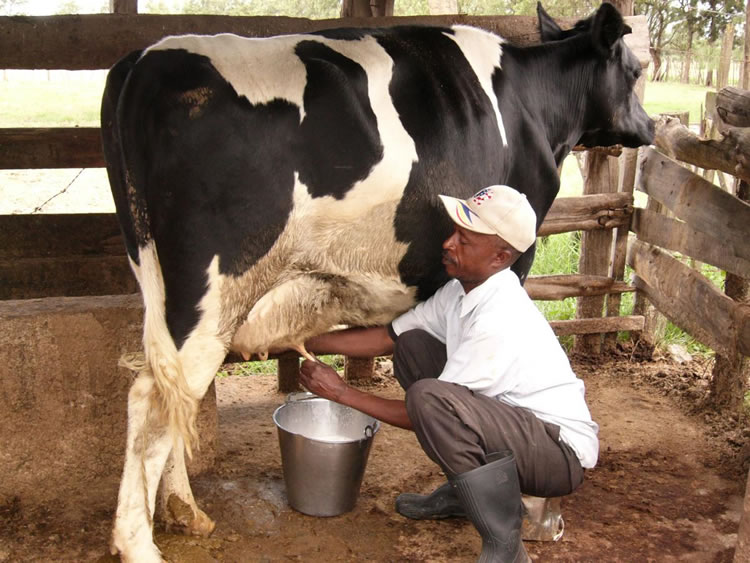What influences milk production in lactating cows?

The heritability of milk production is around 30% i.e. one third, whilst 70% i.e. two thirds is attributed to environment. The extend to which the genetic production potential depends on the ability of the dairy farmer to control environment factors to the advantage of the cow by creating a conducive environment for a cow to reach its potential.
Stage of Lactation
After calving milk production usually rises rapidly until the peak is reached 30 to 60 days later. The production peak reached influences the total production considerably. The period before peak production is usually longer with highly productive cows. Once the peak has been reached, production gradually starts to decrease at about 5% to 6% per month if the cow is not pregnant. When a cow is five months pregnant the tempo of milk reduction starts to increase. Heifers that are first calvers the tempo of decrease after peak production is 3% to 4% per month.
Feeding
For optimal milk production the ration must contain sufficient energy, protein, crude fibre vitamins and minerals cows produce approximately half of their total milk yield during the first 100 days of lactation. For this reason it is essential to feed cows properly during the early days of lactation.
Feed intake is poor at the beginning of lactation but improves as lactation increases. As feed intake is not proportional with milk production requirements the cow possess the unique ability to utilize her body reserves for milk production.
The lactating cow usually losses weight at the beginning of lactation as a result of withdrawal of her body reserves until a point when she reaches her peak. Cows can even under good feeding conditions lose as much as 66kg in body mass during the first three months of lactation. From 120 days after calving the body mass gradually increases until calving.
In order to exploit the potential milk production of a cow the feeding of a dairy cow should be divided into four stages as follows: –
- Feeding stage before calving
- Feeding stage during early lactation (0-100 days after calving). At the beginning of lactation the dairy cow does not have the appetite or the capacity to take in sufficient forage according to her feeding requirements and it is therefore essential that feeding concentration of dry material be considerably increased during this period, while poor quality roughage is undesirable. As already mentioned body reserves are now utilized for milk production. If a highly production cow does not have sufficient body reserves she will not reach her production peak, consequently milk production will be adversely affected.
- Feeding stage during mid lactation (100 to 240 days after calving). If a cow is not fed well during early lactation, maximum production will not be obtained by feeding them extremely well during mid lactation. Sharp increase in feeding in mid lactation will result in an increase in body mass (fattening) rather than in an increase in production especially in poor productive cows. High quality hay should be fed during this period As a result of good feeding during early lactation extra milk can be produced during mid lactation at relatively little expense.
- Feeding stage during late lactation 241-300 days after calving. Late lactation must be regarded as a period of recovery and preparation for the next early lactation research results indicate that body reserves are accumulated more effectively during this period than during the dry period.
Age: Milk production rises slowly up to age of eight years, depending on the breed and reduces fast. Mature cattle produce about 25% more milk than two years old heifers. Heifers must be inseminated at such a time that they calve when 24 months of age or earlier.
Size of Cow: Longer cows generally produce more milk than small cows but milk yield is not related to body mass.
Breed: Milk production is partly a hereditary characteristic.
Number of Milking/Day: Cows milked twice a day at intervals of 10 hours and 14 hours or 8 hours and 16 hours produce approximately the same amount of milk as those milked at intervals of 12 hours. Three milking per day increases production by 10-25% and four milking further increase of 5 to 15%.
Oestrus: When oestrus occurs milk yield may temporarily decrease for a day or two but is negligible.
Dry Period: A dry period of 60 days between lactation is essential for fair milk production during the ensuring lactation.
Climate: Milk production drops when the environmental temperature rises to 30ºc. This is due to a drop in feed intake in an attempt to prevent over heating. Heat stress influences high milk producers more than low milk producers and are especially harmful during peak production. Small breeds are more resistant to heat stress than large breeds. An increase in temperature is more harmful than a drop. The provision of shade e.g. planting trees or shade nettings cannot be over emphasized.
Exercise: Moderate exercise for dairy cattle promotes production highly. Cows on grazing use 50 to 100% more energy for maintenance than cows in non- grazing system (zero grazing).
Diseases: Diseases such as mastitis, ketosis, milk fever and digestive disturbances can cause a decrease in production. The occurrence of such-clinical mastitis causes 10% decrease in production.
Management: High producing cows are usually highly strung and excitement causes a decrease in milk production. Good supervision before and during milking is absolutely essential for optimal production. Cows should never be driven to the milking parlour quickly. Regularity should be maintained in milking and feeding times. Care should be taken that the cows are milked dry. Incomplete milking occurs when the milkers are inefficient, when the milking machine hurts the cow, and this can cause mastitis through inflammation.
Very impressive, thanks for the info
Very impressive knowledge